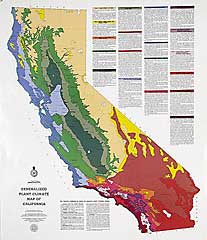
What is my climate zone?
Still in need of more information? Advice to Grow By - Ask Us HERE!
 Buy map" title="Generalized Plant Climate Map of California
Buy map" title="Generalized Plant Climate Map of CaliforniaBuy map" />
Buy map
Most gardening books, catalogs, and seed packets refer to plant hardiness zones, climate zones, or growing zones. Temperature hardiness climate zones are based on normally expected high and low temperatures and serve as guides to help you know which plants will grow where you live.
Temperature is not the only factor in figuring out whether a plant will survive in your garden. Soil types, rainfall, day length, wind, humidity, and heat also play their roles. Even within a city, a street, or a spot protected by a warm wall in your own garden, there may be microclimates that affect how plants grow. The zones are only a guide and a good starting point, but you still need to determine for yourself what will and won't work in your garden.
Of 24 climate zones defined in the Sunset Western Garden Book and the 20 zones defined by the United States Department of Agriculture (USDA), California has 20 and 16, respectively.
The USDA plant hardiness map divides North America into 11 hardiness zones. Zone 1 is the coldest; zone 11 is the warmest. When you order plants from catalogs or read general garden books, you need to know your USDA zone in order to be able to interpret references correctly. The Arbor Day Foundation has also issued a Hardiness Zone Map.
Gardeners in the western United States sometimes are confused when confronted with the 11 Hardiness Zones created by the USDA, because we are used to a 24-zone climate system created by Sunset Magazine. The Sunset zone maps, considered the standard gardening references in the West, are more precise than the USDA's, since they factor in not only winter minimum temperatures, but also summer highs, lengths of growing seasons, humidity, and rainfall patterns.
